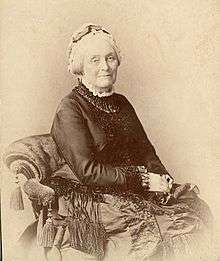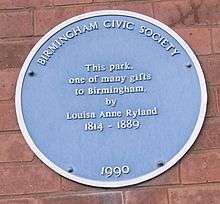Louisa Ryland
| Louisa Anne Ryland | |
|---|---|
 | |
| Born |
14 January 1814 Edgbaston, Birmingham |
| Died |
28 January 1889 (aged 75) Barford, Warwickshire |
| Cause of death | Bronchitis |
| Resting place | Sherbourne, Warwickshire |
| Known for | Philanthropy |
Louisa Anne Ryland (14 January 1814 – 28 January 1889)[1][2][3] was a major benefactor to the (then) town of Birmingham, England.[3] She became a millionaire on the death of her father, Samuel Ryland of The Laurels, Hagley Road, Edgbaston, whose family fortune was made in the wire drawing industry by his father, John Ryland.[2][3]
Her donations included several large areas of land that were used to create public parks. The largest of these, donated in 1873, was some 80 acres (320,000 m2) and became Cannon Hill Park.[3][4] Another, in 1879, was Victoria Park (now Small Heath Park), Small Heath.[3][5] She also contributed to the building of Birmingham School of Art.
When she died, her estate was reputedly valued at around £2,000,000.[3]

Birmingham was made a city in 1889, the year she died. She is commemorated today by Louisa Ryland House,[6] which houses the city’s social services and housing departments, and the city’s Ryland Street.[7]
A reredos was erected in John's Church in Sparkhill in her memory.
References
- ↑ "Obituary". The Times. London, England. 29 January 1889. p. 7.
- 1 2 "Death of Miss Ryland". Leamington Spa Courier. 2 February 1889. p. 5. Retrieved 2014-08-06 – via The British Newspaper Archive. (subscription required (help)).
- 1 2 3 4 5 6 "Louisa Ryland". Digital Ladywood. Retrieved 11 April 2012.
- ↑ 52°27′11″N 1°54′04″W / 52.453°N 1.901°W
- ↑ 52°27′57″N 0°51′14″E / 52.46576°N .85385°E
- ↑ 52°28′54″N 1°54′09″W / 52.481572°N 1.902601°W
- ↑ 52°28′33″N 1°55′08″W / 52.475735°N 1.918896°W